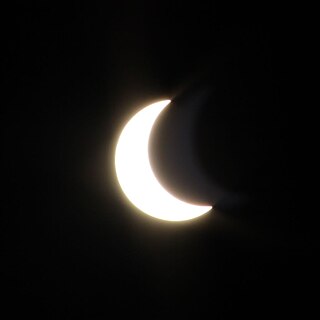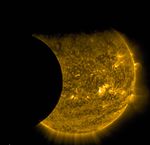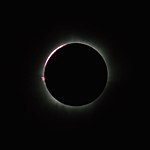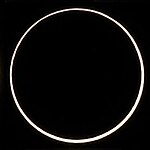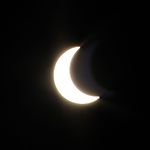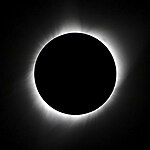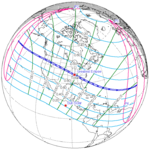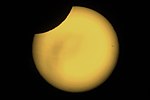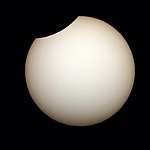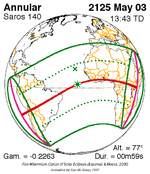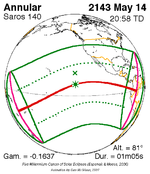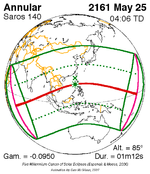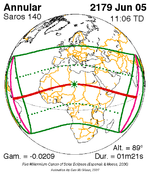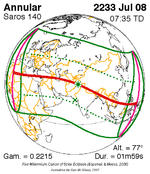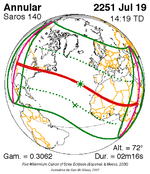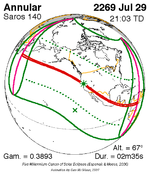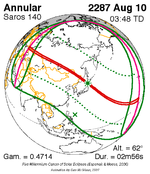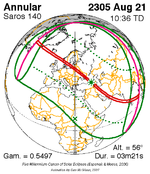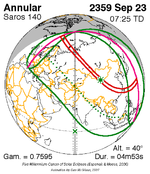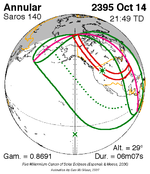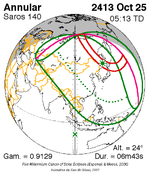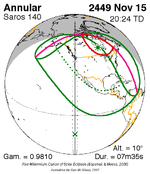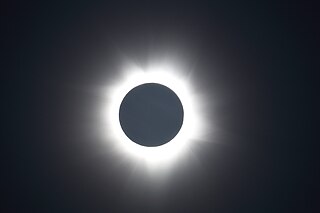
A total solar eclipse took place on 13–14 November 2012 (UTC). Because it crossed the International Date Line it began in local time on November 14 west of the date line over northern Australia, and ended in local time on November 13 east of the date line near the west coast of South America. Its greatest magnitude was 1.0500, occurring only 12 hours before perigee, with greatest eclipse totality lasting just over four minutes. A solar eclipse occurs when the Moon passes between Earth and the Sun, thereby totally or partly obscuring the image of the Sun for a viewer on Earth. A total solar eclipse occurs when the Moon's apparent diameter is larger than the Sun's, blocking all direct sunlight, turning day into darkness. Totality occurs in a narrow path across Earth's surface, with the partial solar eclipse visible over a surrounding region thousands of kilometres wide.

A total solar eclipse occurred at the ascending node of the Moon's orbit on Tuesday, July 2, 2019, with an eclipse magnitude of 1.0459. Totality was visible from the southern Pacific Ocean east of New Zealand to the Coquimbo Region in Chile and Central Argentina at sunset, with the maximum of 4 minutes 33 seconds visible from the Pacific Ocean. The Moon was only 2.4 days before perigee, making it fairly large.

An annular solar eclipse took place at the Moon's descending node of the orbit on May 9–10 (UTC), 2013, with a magnitude of 0.9544. A solar eclipse occurs when the Moon passes between Earth and the Sun, thereby totally or partly obscuring the image of the Sun for a viewer on Earth. An annular solar eclipse occurs when the Moon's apparent diameter is smaller than the Sun's, blocking most of the Sun's light and causing the Sun to look like an annulus (ring). An annular eclipse appears as a partial eclipse over a region of the Earth thousands of kilometres wide.

An annular solar eclipse occurred on Sunday, June 21, 2020. An annular solar eclipse is a solar eclipse whose presentation looks like a ring, or annulus; it occurs when the Moon's apparent diameter is smaller than the Sun's, blocking most, but not all, of the Sun's light. In this instance, the Moon's apparent diameter was 0.6% smaller than the Sun's.

An annular solar eclipse occurred on Thursday, June 10, 2021, when the Moon passed between Earth and the Sun, thereby partly obscuring the image of the Sun for a viewer on Earth. During the eclipse, the Moon's apparent diameter was smaller than the Sun's, so it caused the Sun to look like an annulus. The annular eclipse was visible from parts of northeastern Canada, Greenland, the Arctic Ocean, and the Russian Far East, whilst the eclipse appeared partial from a region thousands of kilometres wide, which included northeastern North America, most of Europe, and northern Asia.

An annular solar eclipse occurred on May 30, 1984. A solar eclipse occurs when the Moon passes between Earth and the Sun, thereby totally or partly obscuring the image of the Sun for a viewer on Earth. An annular solar eclipse occurs when the Moon's apparent diameter is smaller than the Sun's, blocking most of the Sun's light and causing the Sun to look like an annulus (ring). An annular eclipse appears as a partial eclipse over a region of the Earth thousands of kilometres wide. Annularity was visible in Mexico, the United States, Azores Islands, Morocco and Algeria. It was the first annular solar eclipse visible in the US in 33 years. The moon's apparent diameter was near the average diameter because occurs 6.7 days after apogee and 7.8 days before perigee.

A total solar eclipse occurred at the Moon's ascending node of the orbit on June 11, 1983. A solar eclipse occurs when the Moon passes between Earth and the Sun, thereby totally or partly obscuring the image of the Sun for a viewer on Earth. A total solar eclipse occurs when the Moon's apparent diameter is larger than the Sun's, blocking all direct sunlight, turning day into darkness. Totality occurs in a narrow path across Earth's surface, with the partial solar eclipse visible over a surrounding region thousands of kilometres wide. Occurring only 48 hours before perigee, the Moon's apparent diameter was larger.

A hybrid solar eclipse occurred on Thursday, April 20, 2023. A solar eclipse occurs when the Moon passes between Earth and the Sun thereby totally or partly obscuring the Sun for a viewer on Earth. A hybrid solar eclipse is a rare type of solar eclipse that changes its appearance from annular to total and back as the Moon's shadow moves across the Earth's surface. Totality occurs in a narrow path across the surface of the Earth, with the partial solar eclipse visible over a surrounding region thousands of kilometers wide. Hybrid solar eclipses are extremely rare, occurring in only 3.1% of solar eclipses in the 21st century.

An annular solar eclipse will occur on Monday, May 31, 2049. A solar eclipse occurs when the Moon passes between Earth and the Sun, thereby totally or partly obscuring the image of the Sun for a viewer on Earth. An annular solar eclipse occurs when the Moon's apparent diameter is smaller than the Sun's, blocking most of the Sun's light and causing the Sun to look like an annulus (ring). An annular eclipse appears as a partial eclipse over a region of the Earth thousands of kilometres wide.

An annular solar eclipse occurred on December 14, 1955. A solar eclipse occurs when the Moon passes between Earth and the Sun, thereby totally or partly obscuring the image of the Sun for a viewer on Earth. An annular solar eclipse occurs when the Moon's apparent diameter is smaller than the Sun's, blocking most of the Sun's light and causing the Sun to look like an annulus (ring). An annular eclipse appears as a partial eclipse over a region of the Earth thousands of kilometres wide.

An annular solar eclipse occurred at the Moon's descending node of the orbit on February 4–5, 1981. A solar eclipse occurs when the Moon passes between Earth and the Sun, thereby totally or partly obscuring the image of the Sun for a viewer on Earth. An annular solar eclipse occurs when the Moon's apparent diameter is smaller than the Sun's, blocking most of the Sun's light and causing the Sun to look like an annulus (ring). An annular eclipse appears as a partial eclipse over a region of the Earth thousands of kilometres wide. This annular solar eclipse was large because the Moon covered 99.4% of the Sun, with a path width of only 25 km . It was visible in Australia, crossing over Tasmania and southern Stewart Island of New Zealand near sunrise on February 5 (Thursday), and ended at sunset over western South America on February 4 (Wednesday). Occurring only 4 days before perigee, the moon's apparent diameter was larger.
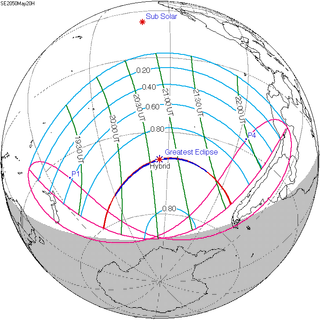
A total solar eclipse will occur on May 20, 2050. A solar eclipse occurs when the Moon passes between Earth and the Sun, thereby totally or partly obscuring the image of the Sun for a viewer on Earth. A total solar eclipse occurs when the Moon's apparent diameter is larger than the Sun's, blocking all direct sunlight, turning day into darkness. Totality occurs in a narrow path across Earth's surface, with the partial solar eclipse visible over a surrounding region thousands of kilometres wide. This eclipse is a hybrid eclipse, starting and ending as an annular solar eclipse.
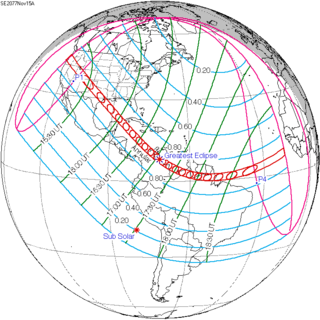
An annular solar eclipse will occur on Monday, November 15, 2077, with a magnitude of 0.9371. A solar eclipse occurs when the Moon passes between Earth and the Sun, thereby totally or partially obscuring the image of the Sun for a viewer on Earth. An annular solar eclipse occurs when the Moon's apparent diameter is smaller than the Sun's, blocking most of the Sun's light and causing the Sun to look like an annulus (ring). An annular eclipse appears as a partial eclipse over a region of the Earth thousands of kilometres wide. The path of annularity will cross North America and South America. This will be the 47th solar eclipse of Saros cycle 134. A small annular eclipse will cover only 93.71% of the Sun in a very broad path, 262 km wide at maximum, and will last 7 minutes and 54 seconds. Occurring only 4 days after apogee, the Moon's apparent diameter is smaller.

A total solar eclipse is forecast to occur on September 4, 2100. It will be the last solar eclipse of the 21st century. A solar eclipse occurs when the Moon passes between Earth and the Sun, thereby totally or partly obscuring the image of the Sun for a viewer on Earth. A total solar eclipse occurs when the Moon's apparent diameter is larger than the Sun's, blocking all direct sunlight, turning day into darkness. Totality occurs in a narrow path across Earth's surface, with the partial solar eclipse visible over a surrounding region thousands of kilometres wide.
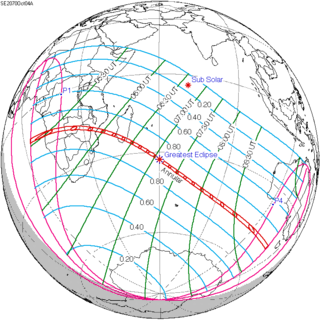
An annular solar eclipse will occur on October 4, 2070. A solar eclipse occurs when the Moon passes between Earth and the Sun, thereby totally or partly obscuring the image of the Sun for a viewer on Earth. An annular solar eclipse occurs when the Moon's apparent diameter is smaller than the Sun's, blocking most of the Sun's light and causing the Sun to look like an annulus (ring). An annular eclipse appears as a partial eclipse over a region of the Earth thousands of kilometres wide.

An annular solar eclipse will occur on Sunday, September 22, 2052. A solar eclipse occurs when the Moon passes between Earth and the Sun, thereby totally or partly obscuring the image of the Sun for a viewer on Earth. An annular solar eclipse occurs when the Moon's apparent diameter is smaller than the Sun's, blocking most of the Sun's light and causing the Sun to look like an annulus (ring). An annular eclipse appears as a partial eclipse over a region of the Earth thousands of kilometres wide.
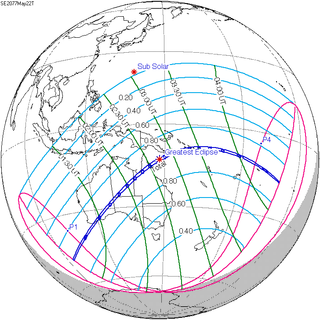
A total solar eclipse will occur on Saturday, May 22, 2077. A solar eclipse occurs when the Moon passes between Earth and the Sun, thereby totally or partly obscuring the image of the Sun for a viewer on Earth. A total solar eclipse occurs when the Moon's apparent diameter is larger than the Sun's, blocking all direct sunlight, turning day into darkness. Totality occurs in a narrow path across Earth's surface, with the partial solar eclipse visible over a surrounding region thousands of kilometres wide.

A total solar eclipse will occur on Monday, May 1, 2079, with a maximum eclipse at 10:48:25.6 UTC. A solar eclipse occurs when the Moon passes between Earth and the Sun, thereby totally or partly obscuring the image of the Sun for a viewer on Earth. A total solar eclipse occurs when the Moon's apparent diameter is larger than the Sun's, blocking all direct sunlight, turning day into darkness. Totality occurs in a narrow path across Earth's surface, with the partial solar eclipse visible over a surrounding region thousands of kilometres wide. The eclipse will be visible in Greenland, parts of eastern Canada and parts of the northeastern United States.

An annular solar eclipse will occur on March 21, 2099. A solar eclipse occurs when the Moon passes between Earth and the Sun, thereby totally or partly obscuring the image of the Sun for a viewer on Earth. An annular solar eclipse occurs when the Moon's apparent diameter is smaller than the Sun's, blocking most of the Sun's light and causing the Sun to look like an annulus (ring). An annular eclipse appears as a partial eclipse over a region of the Earth thousands of kilometres wide.

An annular solar eclipse occurred on August 10, 1934, with an eclipse magnitude of 0.9436. A solar eclipse occurs when the Moon passes between Earth and the Sun, thereby totally or partly obscuring the image of the Sun for a viewer on Earth. An annular solar eclipse occurs when the Moon's apparent diameter is smaller than the Sun's, blocking most of the Sun's light and causing the Sun to look like an annulus (ring). An annular eclipse appears as a partial eclipse over a region of the Earth thousands of kilometres wide.
